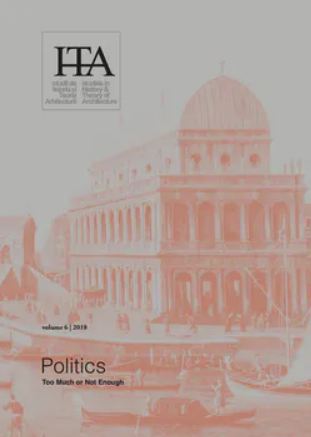The Socio-pol-ethical Confluence of the Architect: The Idiot, the Activist and the Dreamer
The Socio-pol-ethical Confluence of the Architect: The Idiot, the Activist and the Dreamer
Author(s): Paco Mejias Villatoro, Tanzil ShafiqueSubject(s): Politics, Architecture, Ethics / Practical Philosophy, Sociology of Art
Published by: Universitatea de Arhitectură şi Urbanism »Ion Mincu«
Keywords: architect; politics; ethics; social; aesthetic;
Summary/Abstract: Architecture and politics are endeavors conceptually connected in an indivisible way. Architecture is the frame for human cohabitation, an activity that is embedded into the necessity of negotiation (for getting agreements), and legitimization (for looking after agreements) – both processes deeply rooted in the political sphere. From the home to the city, architecture reflects negotiation with others, as for instance, for a fair distribution of property, light or air in all the rooms of a house or in all the buildings of a city. This negotiation is driven by the architect who is legitimized to do so on behalf of the community, thus becoming a political agent responsible for the welfare of the community with respect to the built environment. The architect is legitimized to apply the Force of the Law in the defense of common interest and goods – that includes the natural, cultural and built heritage. Hence, architecture can be understood as legitimized built-violence acting against individuals on behalf of the community for reorganizing people’s lives according to moral laws and/or political interests. From the formal separation of bedrooms in a home to the hierarchical geometry of planned cities, we can see a wide variety of situations where architecture forces people to live in an “unnatural” way. Louis Kahn remarked, “architecture is what nature cannot make. Architecture is something unnatural but not something made up.” In contrast, we can find weak architectural framing in some communities (say, the Kalahari tribes), where relaxed morale promotes togetherness. A similar cohesiveness is observed in the non-hierarchical urban fabrics of informal settlements. Both contexts are characterized by their political informality. The connection between the formality of politics and architecture is also a demonstration of the strong link between both missions.
Journal: sITA – studii de Istoria şi Teoria Arhitecturii
- Issue Year: 2018
- Issue No: 6
- Page Range: 15-26
- Page Count: 12
- Language: English

